Selecting updated AI-900 dumps (Pass4itSure AI-900 dumps) online is the most effective Microsoft Azure AI Fundamentals learning material.
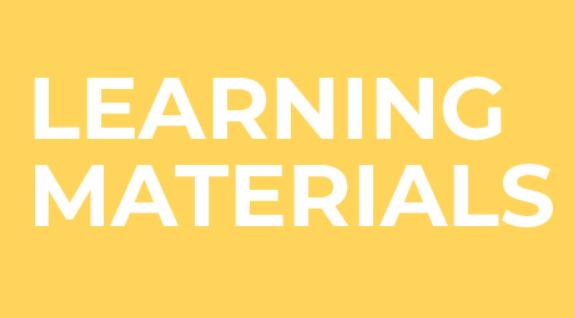
Pass4itSure provides learning materials in two formats (AI-900 PDF, and AI-900 VCE).
From here, go to the Microsoft AI-900 dumps page: https://www.pass4itsure.com/ai-900.html Refreshed with 170 practice questions and answers, purchase it and you’ll easily take the Microsoft Azure AI Fundamentals exam.
Free Download Real AI-900 Questions & Answers PDF file from: https://drive.google.com/file/d/1SJAj3KgvEURFP1Q_GQH3oCS3F57t6Zhy/view?usp=sharing
Is this the Microsoft Azure AI Fundamentals AI-900 exam you know?
If you want to successfully pass this certification exam, you must know it:
Full name: Microsoft Azure AI Fundamentals
Abbreviation: AI-900
Passing score: 700
Languages: English, Japanese, Chinese (Simplified), Korean, German, French, Spanish, Portuguese (Brazil), Russian, Indonesian (Indonesia), Arabic (Saudi Arabia), Chinese (Traditional), Italian
Skill:
Describe Artificial Intelligence workloads and considerations
Describe fundamental principles of machine learning on Azure
Describe features of computer vision workloads on Azure
Describe features of Natural Language Processing (NLP) workloads on Azure
Cost: $99
Official Learning Resources:
Microsoft Azure AI Fundamentals: Get started with artificial intelligence
Microsoft Azure AI Fundamentals: Explore visual tools for machine learning
Microsoft Azure AI Fundamentals: Explore computer vision
Microsoft Azure AI Fundamentals: Explore natural language processing
Microsoft Azure AI Fundamentals: Explore decision support
Microsoft Azure AI Fundamentals: Explore knowledge mining
Additional Resources:
Pass4itSure AI-900 Dumps
Certification: Microsoft Certified: Azure AI Fundamentals
Microsoft Certified: Azure AI Fundamentals Acquisition Process:

People always ask, how hard is the AI-900 exam?
It is not difficult to be a subjective feeling of the individual. I would say that any exam can be easily passed as long as you are prepared. It’s not hard to take the AI-900 exam, you need to be prepared for the exam, and you need valid Microsoft Azure AI Fundamentals learning materials, such as the Pass4itSure AI-900 dumps. It provides valid answers to exam questions and will give you a good practical experience.
Read Microsoft AI-900 free dumps (free sample questions):
QUESTION # 1
DRAG DROP You need to scan the news for articles about your customers and alert employees when there is a negative article. Positive articles must be added to a press book. Which natural language processing tasks should you use to complete the process?
To answer, drag the appropriate tasks to the correct locations. Each task may be used once, more than once, or not at all. You may need to drag the split bar between panes or scroll to view content.
NOTE: Each correct selection is worth one point.
Select and Place:
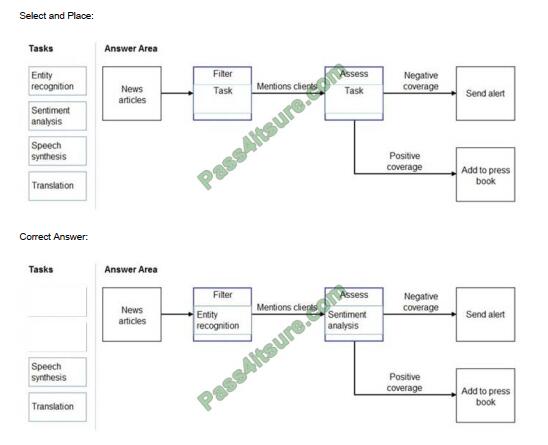
Box 1: Entity recognition
the Named Entity Recognition module in Machine Learning Studio (classic), to identify the names of things, such as people, companies, or locations in a column of text. Named entity recognition is an important area of research in machine learning and natural language processing (NLP) because it can be used to answer many real-world questions, such as:
Which companies were mentioned in a news article? Does a tweet contain the name of a person? Does the tweet also provide his current location? Were specified products mentioned in complaints or reviews?
Box 2: Sentiment Analysis
The Text Analytics API\’s Sentiment Analysis feature provides two ways of detecting positive and negative sentiment.
If you send a Sentiment Analysis request, the API will return sentiment labels (such as “negative”, “neutral” and “positive”) and confidence scores at the sentence and document level.
Reference:
https://docs.microsoft.com/en-us/azure/machine-learning/studio-module-reference/named-entity-recognition
https://docs.microsoft.com/en-us/azure/cognitive-services/text-analytics/how-tos/text-analytics-how-to-sentimentanalysis
QUESTION # 2
HOTSPOT
For each of the following statements, select Yes if the statement is true. Otherwise, select No.
NOTE: Each correct selection is worth one point.
Hot Area:
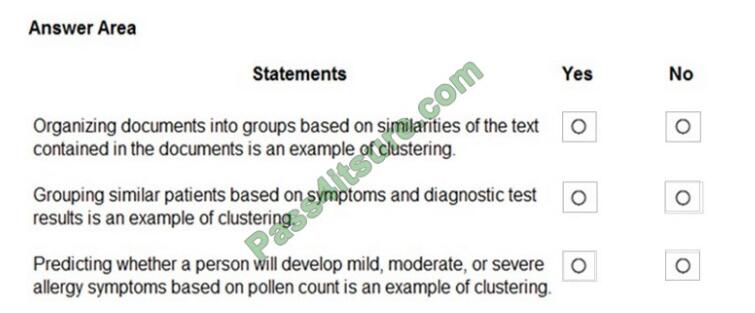
Correct Answer:
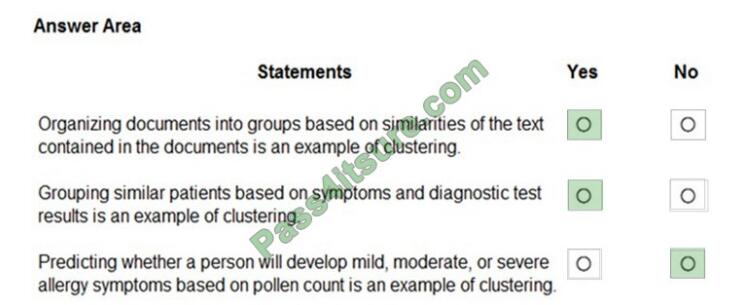
Clustering is a machine learning task that is used to group instances of data into clusters that contain similar characteristics. Clustering can also be used to identify relationships in a dataset Regression is a machine learning task that is used to predict the value of the label from a set of related features.
Reference:
https://docs.microsoft.com/en-us/dotnet/machine-learning/resources/tasks
QUESTION # 3
You need to predict the income range of a given customer by using the following dataset.

Which two fields should you use as features? Each correct answer presents a complete solution. NOTE: Each correct selection is worth one point.
A. Education Level
B. Last Name
C. Age
D. Income Range
E. First Name
Correct Answer: AC
First Name, Last Name, Age, and Education Level are features. Income range is a label (what you want to predict). First Name and Last Name are irrelevant in that they have no bearing on income. Age and Education level are the features you should use.
QUESTION # 4
DRAG-DROP
Match the Microsoft guiding principles for responsible AI to the appropriate descriptions.
To answer, drag the appropriate principle from the column on the left to its description on the right. Each principle may be used once, more than once, or not at all.
NOTE: Each correct selection is worth one point.
Select and Place:
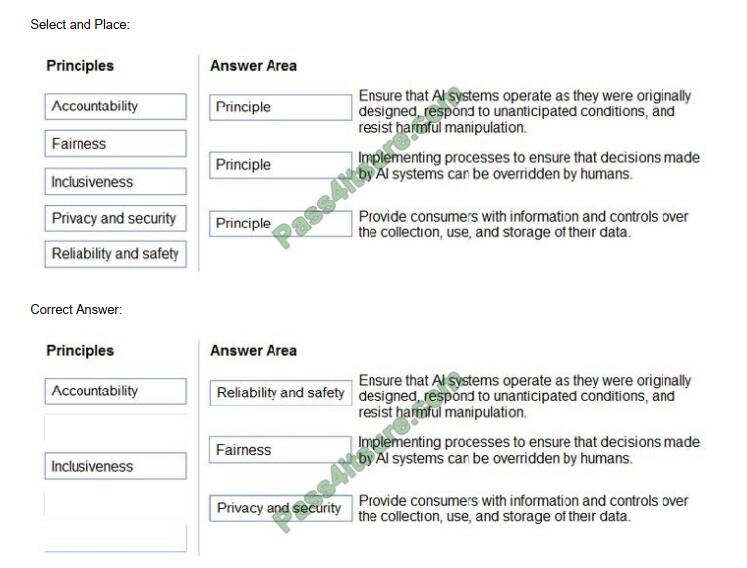
Box 1: Reliability and safety To build trust, it\’s critical that AI systems operate reliably, safely, and consistently under normal circumstances and in unexpected conditions. These systems should be able to operate as they were originally designed, respond safely to unanticipated conditions, and resist harmful manipulation.
Box 2: Fairness Fairness: AI systems should treat everyone fairly and avoid affecting similarly situated groups of people in different ways. For example, when AI systems provide guidance on medical treatment, loan applications, or employment, they should make the same recommendations to everyone with similar symptoms, financial circumstances, or professional qualifications.
We believe that mitigating bias starts with people understanding the implications and limitations of AI predictions and recommendations. Ultimately, people should supplement AI decisions with sound human judgment and be held accountable for consequential decisions that affect others.
Box 3: Privacy and security As AI becomes more prevalent, protecting the privacy and securing important personal and business information are becoming more critical and complex. With AI, privacy and data security issues require especially close attention because access to data is essential for AI systems to make accurate and informed predictions and decisions about people. AI systems must comply with privacy laws that require transparency about the collection, use, and storage of data and mandate that consumers have appropriate controls to choose how their data is used.
Reference: https://docs.microsoft.com/en-us/learn/modules/responsible-ai-principles/4-guiding-principles
QUESTION # 5
Which AI service can you use to interpret the meaning of user input such as “Call me back later?”
A. Translator Text
B. Text Analytics
C. Speech
D. Language Understanding (LUIS)
Correct Answer: B
Text Analytics is an AI service that uncovers insights such as sentiment, entities, and key phrases in unstructured text.
Incorrect Answers:
D: Language Understanding (LUIS) is a cloud-based API service, not an AI service, that applies custom machine learning intelligence to a user\’s conversational, natural language text to predict overall meaning, and pull out relevant, detailed information.
Reference: https://azure.microsoft.com/en-us/services/cognitive-services/text-analytics/
https://docs.microsoft.com/en-us/azure/cognitive-services/luis/what-is-luis
QUESTION # 6
You need to provide content for a business chatbot that will help answer simple user queries.
What are three ways to create question and answer text by using QnA Maker? Each correct answer presents a complete solution. NOTE: Each correct selection is worth one point.
A. Generate the questions and answers from an existing webpage.
B. Use automated machine learning to train a model based on a file that contains the questions.
C. Manually enter the questions and answers.
D. Connect the bot to the Cortana channel and ask questions by using Cortana.
E. Import chit-chat content from a predefined data source.
Correct Answer: ACE
Automatic extraction
Extract question-answer pairs from semi-structured content, including FAQ pages, support websites, excel files, SharePoint documents, product manuals, and policies.
Reference:
https://docs.microsoft.com/en-us/azure/cognitive-services/qnamaker/concepts/content-types
QUESTION # 7
What are two tasks that can be performed by using the Computer Vision service? Each correct answer presents a complete solution. NOTE: Each correct selection is worth one point.
A. Train a custom image classification model.
B. Detect faces in an image.
C. Recognize handwritten text.
D. Translate the text in an image between languages.
Correct Answer: BC
B: Azure\’s Computer Vision service provides developers with access to advanced algorithms that process images and return information based on the visual features you\’re interested in. For example, Computer Vision can determine whether an image contains adult content, find specific brands or objects, or find human faces.
C: Computer Vision includes Optical Character Recognition (OCR) capabilities. You can use the new Read API to extract printed and handwritten text from images and documents.
Reference: https://docs.microsoft.com/en-us/azure/cognitive-services/computer-vision/home
QUESTION # 8
You need to develop a chatbot for a website. The chatbot must answer users’ questions based on the information in the following documents:
1. A product troubleshooting guide in a Microsoft Word document
2. A frequently asked questions (FAQ) list on a webpage Which service should you use to process the documents?
A. Azure Bot Service
B. Language Understanding
C. Text Analytics
D. QnA Maker
Correct Answer: D
Reference: https://docs.microsoft.com/en-us/azure/cognitive-services/QnAMaker/Overview/overview
QUESTION # 9
HOTSPOT
For each of the following statements, select Yes if the statement is true. Otherwise, select No.
NOTE: Each correct selection is worth one point.
Hot Area:
Correct Answer:
Box 1: No
The validation dataset is different from the test dataset that is held back from the training of the model.
Box 2: Yes
A validation dataset is a sample of data that is used to give an estimate of model skill while tuning model\’shyperparameters.
Box 3: No
The Test Dataset, not the validation set, was used for this. The Test Dataset is a sample of data used to provide an unbiased evaluation of a final model fit on the training dataset.
Reference:
https://machinelearningmastery.com/difference-test-validation-datasets/
QUESTION # 10
You use Azure Machine Learning designer to publish an inference pipeline.
Which two parameters should you use to consume the pipeline? Each correct answer presents part of the solution. NOTE: Each correct selection is worth one point.
A. the model name
B. the training endpoint
C. the authentication key
D. the REST endpoint
Correct Answer: AD
A: The trained model is stored as a Dataset module in the module palette. You can find it under My Datasets. Azure Machine Learning designer lets you visually connect datasets and modules on an interactive canvas to create machine learning models.
D: You can consume a published pipeline on the Published pipelines page. Select a published pipeline and find the REST endpoint of it.
Reference: https://docs.microsoft.com/en-us/azure/machine-learning/how-to-run-batch-predictions-designer
https://docs.microsoft.com/en-us/azure/machine-learning/concept-designer
QUESTION # 11
HOTSPOT
You are developing a model to predict events by using classification.
You have a confusion matrix for the model scored on test data as shown in the following exhibit.
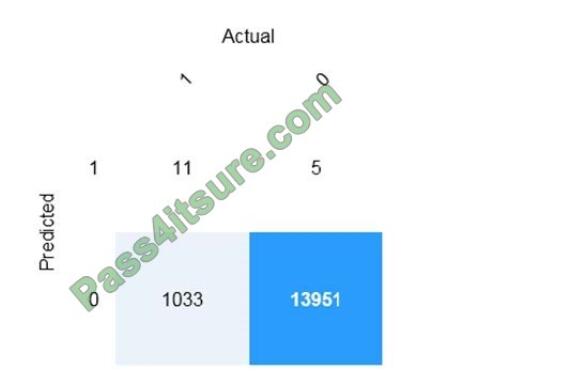
Use the drop-down menus to select the answer choice that completes each statement based on the information presented in the graphic.
NOTE: Each correct selection is worth one point.
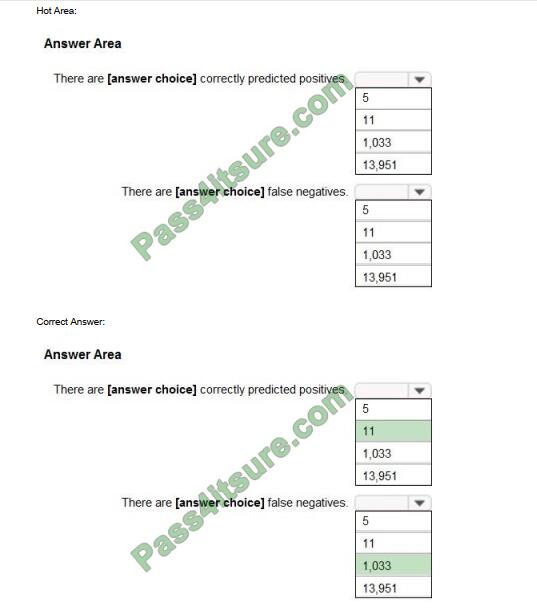
Box 1: 11
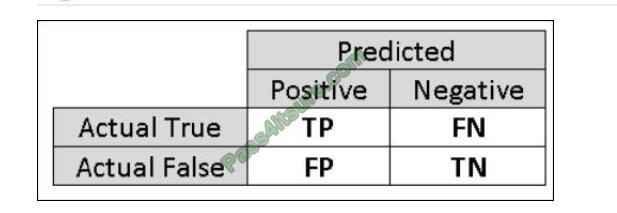
TP = True Positive.
The class labels in the training set can take on only two possible values, which we usually refer to as positive or negative. The positive and negative instances that a classifier predicts correctly are called true positives (TP) and true negatives (TN), respectively. Similarly, the incorrectly classified instances are called false positives (FP) and false negatives (FN).
Box 2: 1,033
FN = False Negative
Reference:
https://docs.microsoft.com/en-us/azure/machine-learning/studio/evaluate-model-performance
QUESTION # 12
Your company wants to build a recycling machine for bottles. The recycling machine must automatically identify bottles of the correct shape and reject all other items. Which type of AI workload should the company use?
A. anomaly detection
B. conversational AI
C. computer vision
D. natural language processing
Correct Answer: C
Azure\\’s Computer Vision service gives you access to advanced algorithms that process images and return information based on the visual features you\\’re interested in. For example, Computer Vision can determine whether an image contains adult content, find specific brands or objects, or find human faces.
Reference: https://docs.microsoft.com/en-us/azure/cognitive-services/computer-vision/overview
QUESTION # 13
HOTSPOT
To complete the sentence, select the appropriate option in the answer area.
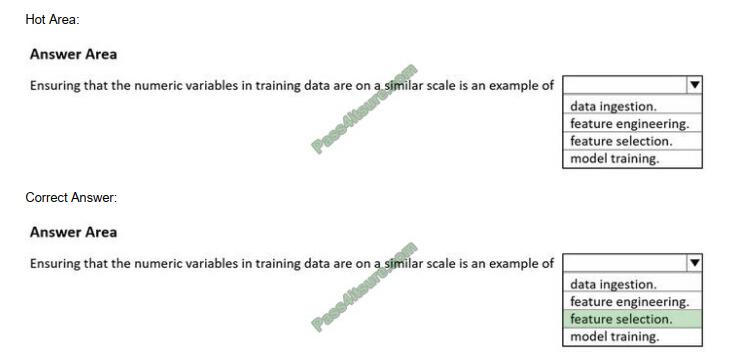
Reference: https://docs.microsoft.com/en-us/azure/architecture/data-science-process/create-features
Want to read more? AI-900 Q&As – this website.
You can also go to the www.microsoft-technet.com blog to see a full range of Microsoft Exam Practice Questions.